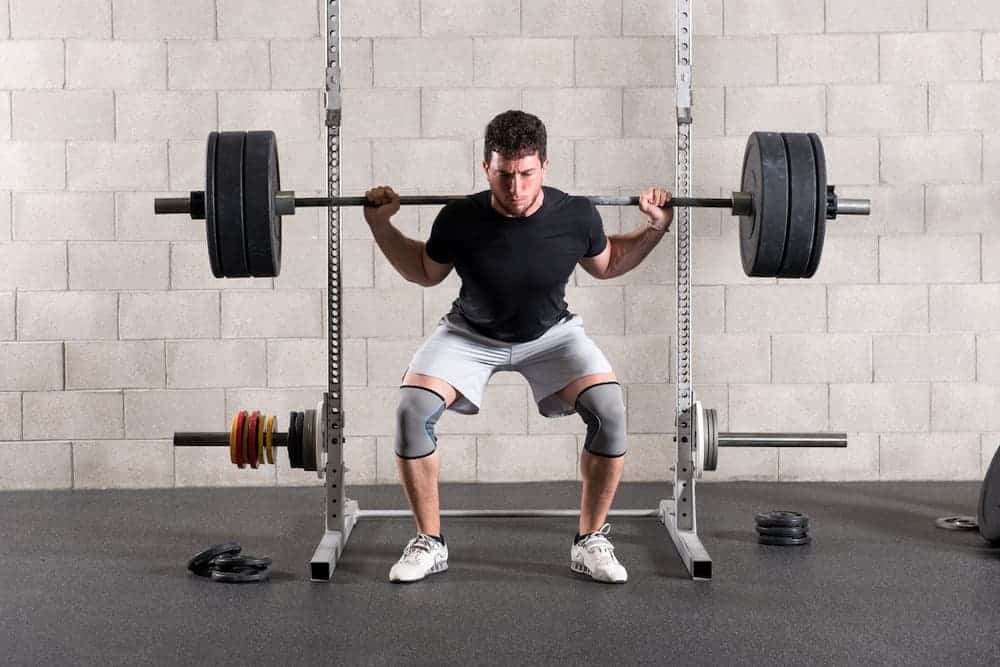Anyone can safely do barbell exercises at home or in the garage with a power cage or a squat rack. Visually, it’s clear that these two home gym essentials are different. But is one better than the other?
And if you plan to purchase either, which gym equipment will work best with your fitness goals, space and budget? Let’s then make decision-making easier by comparing the two!
Squat Rack VS Power Cage: The Difference
A squat rack or half rack comes with two steel posts connected to a stable base. It also has a pair of J-hooks or safety arms to hold a barbell.
As you are likely to train alone at home, the safety bars are like your spotter that prevents a barbell from crashing into you.
Depending on the rack model, some have adjustable safety bars, and some don’t.
The power or squat cage, on the other hand, is the squat rack’s bigger brother. Instead of two upright posts, a power rack has four, thus the cage-like appearance.
Other power cages even have up to eight uprights. The interlinked vertical posts of this piece of gym equipment add stability.
Both racks are ideal for strength training or weightlifting. However, they do have structural and functional differences.
Here are some of them.

Safety
Squats, bench presses and other Olympic barbell moves can be dangerous to pull off without a spotter. But if you prefer to train alone, a squat or power rack increases your safety. A cage, however, is the safest option.
With a squat rack, it’s difficult to dump the bar if you train too far from it. In some models without safety bars, you can only drop the bar into the floor.
But inside a power rack, you can lift the bar forward or backward and stay safe on both ends. You need not worry about dumping the bar in the right direction.
Also, you can use safety straps or pins for your full rack as your catcher.
Verdict: A power cage’s variable safety features and encased design ensure better security.
Stability
A related safety factor to consider when choosing between a squat and a full rack is stability, particularly their solid base.
Considering that a power rack has four uprights and wider bases, it can withstand variable loads without moving or tipping over.
That doesn’t mean that all squat racks are less stable and substandard, though. With high-grade uprights, quality rubberised foot caps and weight balance, a squat rack can surely outdo a low-cost cage.
But in general, if you plan to work on heavier weights, choose a heavy-duty cage that you can bolt into the floor.
Verdict: Both are stable, depending on construction quality. But a power cage provides higher stability for heavy-weight lifters.

Space-Efficiency
A full rack requires more room than a squat rack. That means, if you have minimal space, go for the more compact equipment. Also, it’s a smart choice if you plan to turn your home gym into a multi-use space.
Later on, you can opt for a 100% home gym and expand your equipment options with a space-friendly squat rack.
Keep in mind, however, that either rack comes with short or tall height options. This spec is crucial if you want to attach a pull-up bar on top.
Make sure you have sufficient headroom, so you can do pull-ups without slamming onto the ceiling. Check out my home gym set-up tips to make the most of your limited space.
Verdict: A more compact squat rack fits most spaces and allows easy home gym expansion in the future.
Versatility
If you are looking for versatile gear and have room for a power cage, this one is your best option. A squat rack lets you do squats and bench presses safely.
But a power rack allows a wide range of exercises, like lunges, rows and deadlifts. Its high weight limit also encourages continuous training progress.
You can quickly max out your squat rack with safety arms, weight storage, band pegs and a pull-up bar. With a power rack, you have more accessory options to enhance its functionality.
For example, you can add a speed bag, belt squat, dip bar and lat pulldown. You can even put additional attachments like a chalk bowl or accessory hangers for training convenience.
Verdict: A power cage offers better exercise diversity. It’s easier to customise to suit individual training needs, too.
Cost
The larger, more versatile cage is naturally pricier than a squat rack. Purchasing additional attachments can also add up to cost. So, if you’re after a budget-friendly choice, go for a half-rack to make your wallet happy.
Just don’t settle on the first cheapest rack you find. Remember, safety rhymes with quality. Make sure to inspect its material and design features thoroughly before buying.
Verdict: A well-made but inexpensive squat rack is best for your budget and safety.

Squat Rack VS Power Cage: The Verdict
It’s easy to see that a power rack wins in most aspects. It may have a larger footprint and higher price tag, but it is also more stable and versatile. In the end, the choice boils down to your fitness level and training goals.
If you’re a weightlifting newbie, a well-built squat rack is perfect for you. With this one, you can test the waters without having to spend a lot.
But for serious weightlifters, a high-quality power rack is a valuable investment with lifelong returns.
Do you think a power cage is your best match? We’ve got a list of power racks in Australia to help you compare and decide!
- Foldable vs Traditional Reformers: Which One’s Right for You? - 2 July 2025
- Elliptical Cross Trainer vs Exercise Bike: Which is Better? - 24 June 2025
- How Do the Different Massage Gun Attachments Work? - 23 June 2025
